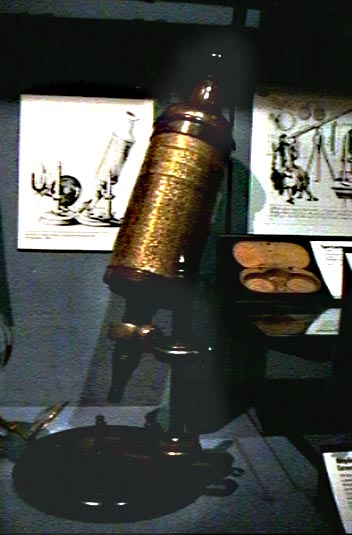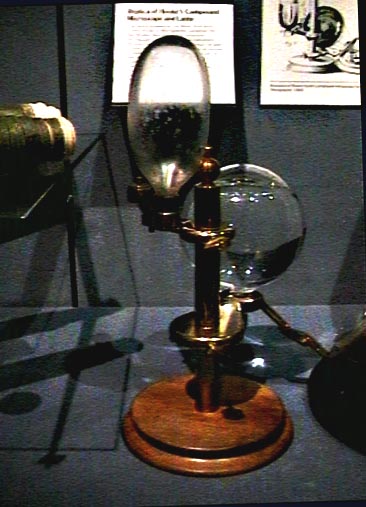English Father of Microscopy
Hooke was not just an observer. When asked to produce a model of the eye for demonstration before the Royal Society,
he created one containing an iris diaphragm. This may well have inspired his creation of an improved compound microscope
- complete with iris diaphragm and independent light source...
 See a 3D image of this microscope. See a 3D image of this microscope.
Replica of a Hooke Microscope on
show at the Science Museum - London.
The illustration from which it was made is behind the microscope. Micrographia, Hooke's first published work contained
details of an improved microscope which influenced microscope makers both then and years later.
Hooke corresponded with several other pioneering microscopists of the day - including Anthony van Leeuwenhoek the
pioneering microscopist in the Netherlands. He demonstrated to the society on the 10th November 1677 - Leeuwenhoek's
discovery of 'minute worms' in pepper water.
It was Hooke therefore who confirmed Anthony van Leeuwenhoek's discoveries of the existence of tiny living organisms
in a variety of waters. He made a copy of Leeunwenhoek's microscope and used it to confirm other observations reported
by him.
They remained in contact via letters, with Hooke's friend Theodore Haak providing translation of Leeuwenhoek's
writings to Hooke during his frequent visits to his home. In one letter to Leeuwenhoek, Robert Hooke commented
that they seemed to be the only two people contributing significantly to the field of microscopical studies.
The first letter from Leeuwenhoek to the society, reporting on his findings, was a paper called 'Microscopium'.
[Author's note: As an aside, it is significant that these two men, between
them, established the field of enthusiast microscopy which the readers of Micscape and many of the visitors of
Mic-UK continue to follow today - nearly 300 years later. It is also interesting to note that it is through original collaboration between Dutch and English enthusiast microscopists (now an International collaboration
involving microscopists throughout the world) Micscape Magazine matured. ]
 See a 3D image of this lamp. See a 3D image of this lamp.
Replica of a Hooke Illumination Device
(his lamp used with microscopical study) on show at the Science Museum - London.
Hooke's skills were as wide as they were formidable. He was adept at making his own tools and instruments, not
only for microscopy, but for astronomy, geology, meteorology, horology (time, clocks), surveying, etc.,
He was able to make his own lenses and mirrors, for use in his telescopes and microscopes.
In his writings, Hooke postulated that one day, improved optics and devices beyond the limitations of the technology
available in the 17th century, might yield greater detail and information regarding microscopical forms.
Today, Scanning Electron microscopes and Tunnel Effect Microscopes reveal incredible detail through overcoming
the limitations imposed by the wavelength of light and the use of glass optics.
Robert Hooke used his observations at the microscope to develop the first notions of how engineering designs of
nature could be applied to man-made designs and artifacts. When studying bee stings and the hairs on stinging nettles
- he considered how their structures and processes could be utilized for transferring liquids into humans: something
that was realized later in history with the introduction of the syringe or hypodermic needle!
Previous Page | Continue... |

